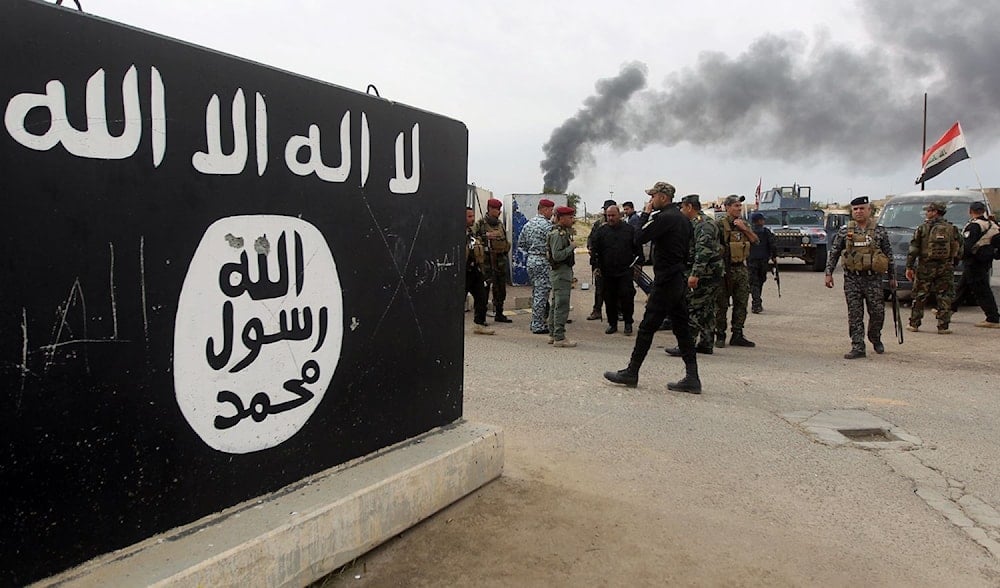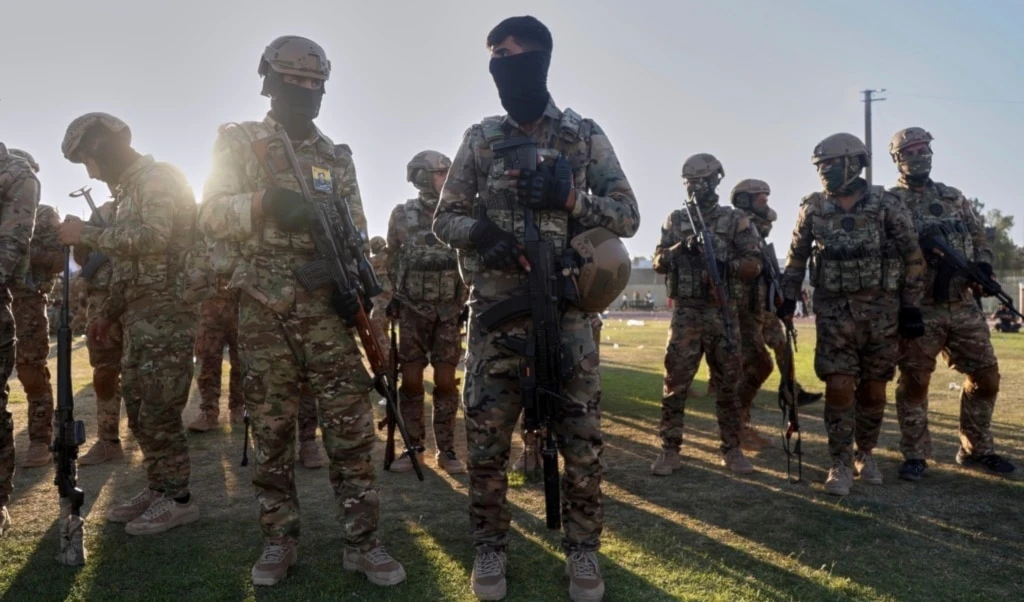Islamic State eyes resurgence in Syria, Iraq, exploiting divisions
IS sleeper cells are reactivating in Syria and Iraq after al-Assad’s fall, but security forces say they’ve foiled major plots, keeping the group from regrouping.
-

Bullet holes appear on an IS mural in Iraq in this undated photo as smoke rises in the background among armed gunmen (AFP)
Middle East and Western officials warn that the Islamic State resurgence in Syria and Iraq is underway, as the group reactivates sleeper cells and prepares for potential attacks in the wake of Syrian President Bashar al-Assad’s fall.
According to over 20 sources, including security officials, diplomats, and analysts, IS operatives have begun redistributing weapons, identifying targets, and recruiting fighters across both countries.
The group’s renewed activity follows years of relative dormancy after its territorial defeat in 2019. But recent instability in post-Assad Syria appears to have created a new opening.
“Islamic State elements have begun to reactivate after years of lying low, emboldened by the chaos in Syria,” said Colonel Abdul Ameer al-Bayati of Iraq’s 8th Division.
Despite these efforts, the actual number of IS attacks remains low. Security forces in both Syria and Iraq say they have foiled at least a dozen major plots in 2025, including a suicide bombing attempt in the northern Iraqi town of Daquq in December.
That attack was disrupted after two IS couriers were intercepted carrying verbal orders to activate sleeper cells, officials said.
IS reactivates networks amid Syrian power vacuum
Since al-Assad’s ouster, Syria has been ruled by Islamist leader Ahmed al-Sharaa. Intelligence agencies and regional observers believe that IS operatives have attempted to exploit this political transition.
SITE Intelligence Group reported that IS sleeper cells in 2025 have claimed just 38 attacks in Syria so far this year, putting the group on pace for a third of its total attacks last year. In Iraq, the figure is even lower, with only four claimed attacks through May.
Syrian authorities, now under al-Sharaa, have acknowledged increased intelligence activity. Defense Minister Murhaf Abu Qasra said in January that the government was building up its surveillance capabilities to counter potential threats.
A US defense official told Reuters that while IS remnants have been weakened, they remain capable of carrying out asymmetric operations.
Foiled operations and arrests suggest IS is attempting to regroup across both countries. After the December incident in Daquq, Iraqi counterterrorism units launched targeted raids based on intelligence gleaned from captured militants.
IS’ efforts to revive its Iraq-Syria counterterrorism footprint have been met with aggressive airstrikes and drone surveillance, according to Iraqi officials.
Foiled attacks reveal coordination across borders
A particularly alarming trend, officials say, is the movement of IS fighters and weapons from rural areas into Syrian cities such as Aleppo, Homs, and Damascus.
Three Syrian political sources confirmed that militants have shifted from the desert into more populated zones. Meanwhile, Iraq’s Hamrin Mountains, historically an IS hideout, have seen increased drone activity and IS-related sightings.
According to Syrian Interior Minister Anas Khattab, “Of the challenges we face, Daesh is at the top of the list.”
IS has been distributing silencers, explosives, and automatic weapons across both countries, in what analysts say may be a restrategizing phase rather than a full-scale resurgence.
One factor complicating the regional response is the presence of foreign fighters. Two European intelligence sources told Reuters that for the first time in years, suspected jihadists have traveled from Europe to Syria, though it remains unclear whether they are joining IS or other militant factions.
Foreign fighters reemerge as Assad’s fall reshapes region
The IS comeback attempt coincides with US President Donald Trump’s diplomatic push in the region. In May, during a meeting in Saudi Arabia, Trump asked al-Sharaa to help curb an IS resurgence, while announcing plans to cut the US troop presence in Syria by half. Trump also lifted sanctions on Syria in what was widely seen as a concession to the interim government.
IS capitalized on these developments, condemning the al-Sharaa-Trump meeting in its publication al-Naba and urging foreign fighters in Syria to defect to its ranks.
Trump and Turkish President Recep Tayyip Erdogan have since called on Damascus to assume responsibility for the approximately 9,000 IS detainees currently held by US-backed Kurdish forces.
Concerns over prison breaks are mounting. The Syrian Democratic Forces (SDF) say there have been at least two attempted escapes since al-Assad’s fall.
Analysts question whether al-Sharaa’s administration can secure these facilities amid clashes with Turkish-backed rebels, ongoing Israeli airstrikes, and assassinations by suspected al-Assad loyalists.
US and regional allies wary of IS jailbreak threats
A senior US defense official confirmed that Washington has exchanged limited intelligence with Damascus, particularly in the context of recent raids in Aleppo that killed three IS militants. The same official said the US would continue “vigilantly monitoring” al-Sharaa’s government, which “has been saying and doing the right things so far.”
Iraq has also adjusted its strategy. Foreign Minister Fuad Hussein told Reuters that Baghdad is communicating regularly with Damascus on IS activity and believes some militants may be attempting to smuggle weapons from Syria into Iraq.
“We hope that Syria will not become a base for terrorists, especially ISIS,” he said.
The United Nations estimates that the Islamic State maintains between 1,500 and 3,000 fighters across both countries, though its strongest branches are now in Africa. The current leader is believed to be Abdulqadir Mumin, who commands the Somali branch, according to US officials.
Counterterrorism efforts continue under pressure
In Iraq, intelligence operatives credit increased precision and the use of drones for keeping IS in check. “We’ve made it harder for them to regroup,” said Sabah al-Numan, spokesperson for Iraq’s counterterrorism division.
Even so, analysts warn that IS remains agile, operating through informal networks and waiting for security vacuums to exploit.
Despite a significant drop in attacks, SITE Director Rita Katz noted that the group may simply be in a quiet phase.
“Far more likely that it has entered a restrategising phase,” she said, cautioning that the decline in activity does not mean the group has been neutralized.
The US-led coalition plans to wind down its operations in Iraq by September. However, two sources confirmed that Baghdad has privately requested that the US slow the drawdown of its 2,500 troops, given growing concerns over regional stability and the shifting landscape in post-Assad Syria.

 6 Min Read
6 Min Read










